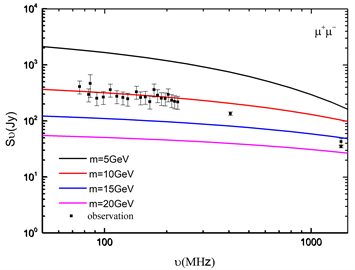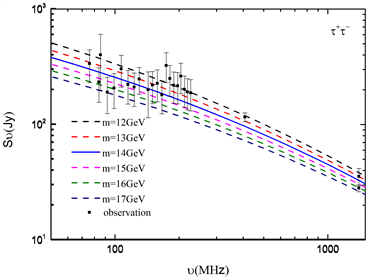Astronomy and Astrophysics
Vol.
07
No.
03
(
2019
), Article ID:
30763
,
9
pages
10.12677/AAS.2019.73004
Study on Synchrotron Radiation Signal and Dark Matter Annihilation Signal in Small Magellanic Cloud
Zhanfang Chen
Department of Astronomy, Xiamen University, Xiamen Fujian

Received: May 23rd, 2019; accepted: June 7th, 2019; published: June 14th, 2019

ABSTRACT
High-energy positrons and electrons lose energy in the magnetic field to produce synchrotron radiation signals. In irregular dwarf galaxies, both dark matter self-annihilation and cosmic rays produce high-energy positrons and electrons. In this paper, we review the synchrotron radiation signals in the Small Magellanic Cloud, an irregular dwarf galaxy in the neighborhood, and compare the constraints on dark matter mass with and without cosmic ray contributions. We first assume that all the synchrotron radiation signals are generated by dark matter annihilation. Given the thermal relic annihilation cross section, the mass constraints on dark matter particles are limited by fitting observed data under the assumption of three different typical dark matter annihilation channels and we find is the best annihilation channel to fit the spectrum shape. Furthermore, we calculate the synchrotron radiation signal generated by cosmic rays through radio-infrared correlation, subtracting the contribution of this part of the detected flux and using the remaining part as the upper limit from the self-annihilation of dark matter. Taking into account annihilation channel, we give the corresponding dark matter mass under the two magnetic field assumptions by adjusting the dark matter mass to fit the data. When the contribution of cosmic rays is reasonably deducted, the upper mass of dark matter particles allowed is larger than that obtained without cosmic ray contribution subtracted at the same thermal annihilation cross-section.
Keywords:Small Magellanic Cloud, Dark Matter, Cosmic Ray

小麦哲伦云同步辐射信号与暗物质湮灭信号的研究
陈占方
厦门大学天文系,福建 厦门

收稿日期:2019年5月23日;录用日期:2019年6月7日;发布日期:2019年6月14日

摘 要
高能正负电子在磁场中损失能量产生同步辐射信号,在不规则矮星系中,暗物质自湮灭和宇宙射线均能提供高能正负电子。在本篇文章中,我们拟重新分析近邻不规则矮星系,小麦哲云中的同步辐射信号,比较了考虑宇宙射线贡献和扣除宇宙射线贡献,对暗物质质量的限制。我们首先假定所有的同步辐射信号由暗物质湮灭产生,在给定热遗迹湮灭截面下,对三种不同的典型暗物质湮灭道下拟合观测数据对暗物质粒子质量的限制。我们发现 湮灭道给出最佳的谱形拟合。进一步,我们通过射电红外关联计算由宇宙射线产生的同步辐射信号,将探测到的流量减掉这部分的贡献,剩下的部分作为暗物质自湮灭产生的上限。同样考虑 湮灭道,我们通过调整暗物质粒子质量拟合数据,给出两种磁场假定下,最佳拟合对应的暗物质质量。我们发现在合理地扣除宇宙射线贡献的情况下,同样的热遗迹截面,限制的暗物质粒子质量更大。磁场更大时,对应暗物质粒子质量的上限更大,对谱线的整体拟合更好。
关键词 :小麦哲伦云,暗物质,宇宙线

Copyright © 2019 by author and Hans Publishers Inc.
This work is licensed under the Creative Commons Attribution International License (CC BY).
http://creativecommons.org/licenses/by/4.0/


1. 引言
现代天文学和宇宙学观测表明,宇宙中大部分物质为不发光的暗物质,然而暗物质的粒子属性仍然不明。一般认为暗物质为弱相互作用的大质量中性粒子,在粒子物理标准模型中找不到满足天文学观测限制的对应粒子 [1] 。超出粒子物理标准模型提供了众多的暗物质候选者,其中超对称模型中的最轻伴随子研究最多。这类暗物质粒子反粒子为其本身,自湮灭反应末代包含正负电子、光子、中微子、反质子等常规粒子。这些粒子在天体系统中传播,与磁场或辐射场等作用,会产生多波段的观测信号。
暗物质间接探测实验致力于探测这类信号,对暗物质自湮灭截面、质量等基本粒子属性进行限制。自湮灭反应诱发的电磁信号强度正比于暗物质密度的平方,因此暗物质密度高的地方其信号应该最强。暗物质主导了星系形成与演化,数值模拟指出星系暗物质晕的密度轮廓随半径的减小而增大,邻近星系中心预计得到的暗物质湮灭信号较容易探测到。银心,银河系的卫星星系,邻近的暗物质子晕均为暗物质间接探测的理想场所。目前,Fermi卫星对银心,矮椭球星系等近邻系统的高能伽马射线的观测对暗物质的粒子参数空间给出了很强的限制 [2] 。
与伽马射线探测互补的是射电探测。自湮灭反应末态中包含正负电子,这些高能带电轻粒子在磁场中损失能量产生在射电波段的同步辐射信号。最近,大型的射电阵列ATCA以及大单天线射电望远镜GBT对银河系的卫星星系进行低频的射电信号搜寻,目前没有探测到弥散的同步辐射信号。这也可能解释为该类星系中的磁场很微弱 [3] [4] [5] 。相比矮椭球星系,不规则矮星系含有气体,磁场一般认为为mG的量级,两个最近的不规则矮星系,大麦哲云和小麦哲云均有大量的射电探测 [6] 。然而不规则矮星系一般由恒星形成,其中探测到的同步辐射信号认为主要是由宇宙射线中的正负电子引起的。不规则矮星系的质光比较高,暗物质密度较大,湮灭产生的正负电子在星系磁场的运动也可能产生可观的同步辐射信号。在前人的工作中,人们利用大麦哲云中的射电和高能光子信号对暗物质进行联合限制 [7] 。
在本篇文章中我们将重点讨论小麦哲云中的同步辐射信号的构成以及对暗物质粒子属性的可能限制。我们将比较考虑宇宙射线贡献和扣除宇宙射线贡献,对暗物质质量的限制。其中,我们拟通过射电红外关联可计算由宇宙射线产生的同步辐射信号,将探测到的流量减掉这部分的贡献,剩下的部分作为暗物质自湮灭产生的上限。第二部分介绍幂律函数拟合射电能谱和宇宙线贡献同步辐射。第三部分介绍通过拟合射电能谱,获取最佳的暗物质质量。第四部分,我们展现我们的结果与讨论。
2. 小麦哲伦云的射电能谱
2.1. 小麦哲伦云射电数据拟合
小麦哲伦云的射电能谱可以通过幂律函数近似,幂律函数的斜率主要取决于热辐射的性质和非热辐射的性质。For et al. (2018)用单幂律拟合表1中的小麦哲伦云非热射电能谱。得到如下关系式:
(1)
其中 和 。图1展示了小麦哲伦云的能谱分布。
Table 1. Radio data from SMC at low frequencies
表1. 小麦哲伦云在低频处的射电数据

Figure 1. Spectral energy distribution of SMC at low frequencies
图1. 在低频处,小麦哲伦云星系的射电能谱分布
2.2. 宇宙线贡献的同步辐射
高能宇宙线电子在磁场存在下,可以产生同步辐射。同步辐射与红外辐射有非常强的线性关系。红外辐射主要是由年轻恒星产生紫外辐射加热尘埃产生的热辐射。这些年轻恒星迅速演化成超新星,其遗迹负责加速宇宙线粒子。射电与红外光度的经验关系为:
(2)
对于小麦哲伦星系,红外光度取值为 [10] 。根据经验公式,宇宙线流量为 。宇宙线流量是频率的幂律函数:
(3)
在文献中也得到了广泛的探讨,我们假设它是0.8 [11] 。因此,我们可以得到宇宙线幂律分布为: 。
3. 限制暗物质粒子属性
暗物质粒子湮灭可以产生高能e+e−。在磁场存在下,高能e+e−在射电波段损失能量产生同步辐射。为了限制暗物质粒子的参数空间,我们需要暗物质湮灭产生e+e−的源函数。
3.1. 源函数
源函数是暗物质湮灭产生e+e−的电子数密度。
(3)
其中 代表小麦哲伦云当地暗物质粒子的密度, 代表暗物质质量, 代表暗物质湮灭截面, 代表电子能谱,本文采用DarkSUSY工具包计算电子能谱 [12] 。图2展示不同湮灭道下,暗物质湮灭产生电子能谱的能量不同。根据等式(2),源函数与电子 能谱呈正比。暗物质湮灭直接产生高能e+e−通常被抑制。暗物质湮灭会产生最终态粒子(如重轻子、夸克与规范玻色子)。因最终态粒子不稳定,还会快速衰变产生标准粒子。在我们论文中标准粒子考虑的是高能e+e−。

Figure 2. Electron spectrums for different annihilation channels
图2. 不同湮灭道的电子能谱
是暗物质粒子密度,我们采用是NFW模型:
(4)
其中
和
为自由参数。对于小麦哲伦星系,
, [13] 。
[13] 。
3.2. 暗物质湮灭同步辐射信号
暗物质湮灭产生同步辐射流量可以近似表达为 [14] :
(5)
对于小麦哲伦云,DA = 60 kpc。同步辐射发射率为 [15] :
(6)
同步辐射发射率是观察者确定流量的基本成分。
(7)
其中 代表电子经典半径, 代表电子的非相对论回旋频率。数值x和F定义如下:
(8)
(9)
其中 是5/3阶修正的贝塞尔函数。单位能量范围单位体积内的电子数为:
(10)
其中电子损失率为:
(11)
在射电波段,磁场是在计算同步辐射流量时的一个重要参数。
3.3. 限制暗物质粒子质量
图3~5分别用不同湮灭道,通过拟合观测数据,得到暗物质粒子质量的限制。磁场取值为5 mG。在相同热遗迹湮灭截面 下,通过改变暗物质质量mχ,我们可以得到不同的流量随频率的变化图。我们首先假定所有的同步辐射信号由暗物质湮灭产生。通过对比三个图,我们可以发现 湮灭道整体拟合能谱效果更好。

Figure 3. The flux varies with frequency for the annihilation channel
图3. 湮灭道的流量随频率变化的关系图

Figure 4. The flux varies with frequency for the annihilation channel
图4. 湮灭道的流量随频率变化的关系图
图5和图6,磁场均取值为5 mG。相对于图5,在暗物质粒子质量上限的合理区间内进行细分,我们发现暗物质粒子质量上限为mχ = 12 GeV最为合理。

Figure 5. The flux varies with frequency for the annihilation channel
图5. 湮灭道的流量随频率变化的关系图

Figure 6. The flux varies with frequency for the annihilation channel
图6. 湮灭道的流量随频率变化的关系图
磁场强度影响同步辐射信号能谱。图7相对于图5,磁场取值1.7 mG。湮灭道均为 。我们可以发现:磁场取值小时,暗物质粒子质量上限变小,并且不能很好拟合整体能谱。

Figure 7. The magnetic field is 1.7 mG and the observed data are fitted
图7. 磁场取1.7 mG,拟合观测数据
图8相对于图6,我们将比较考虑宇宙射线贡献对射电流量贡献,扣除宇宙线流量贡献后,进一步对暗物质质量上限进行限制。磁场取值为5 mG,在相同的热湮灭截面相同情况下,扣除宇宙线后,暗物质粒子质量上限变大。

Figure 8. After deducting cosmic rays, we fit the radio spectrum
图8. 扣除宇宙线,我们拟合射电频谱
4. 结论
在本文中我们同时考虑了暗物质湮灭产生的高能e+e−和宇宙线高能e+e−的小麦哲云中探测到的同步辐射信号的贡献。通过对小麦哲伦云的低频射电观测能谱的拟合,给出对暗物质粒子质量的限制。我们首先假定暗物质湮灭贡献所有同步辐射信号,在给定热遗迹湮灭截面下,比较了三种不同的典型暗物质湮灭道下拟合观测数据对暗物质粒子质量的限制,发现 湮灭道给出的谱形拟合最佳。我们进一步基于射电红外关联计算了宇宙线正负电子贡献的同步辐射信号,发现在频率为1.4 GHz处,这个信号低于小麦哲伦云探测到的射电流量。扣除宇宙线对射电流量贡献后,我们可以获得暗物质湮灭对流量的贡献。我们对比考虑宇宙射线贡献和扣除宇宙射线贡献,拟合能谱来限制暗物质参数空间。在合理地扣除宇宙射线贡献的情况下,同样的热遗迹截面,暗物质粒子的上限质量更大。在相同的暗物质湮灭道的假定下,我们通过改变暗物质粒子质量拟合数据,给出两种磁场假定下,最佳拟合对应的暗物质质量。磁场更大时,对应暗物质粒子质量的上限更大,对谱线的整体拟合更好。
基金项目
国家自然科学基金资助项目11890692。
致谢
感谢厦门大学黄峰老师对本课题有用的建议和讨论。
文章引用
陈占方. 小麦哲伦云同步辐射信号与暗物质湮灭信号的研究
Study on Synchrotron Radiation Signal and Dark Matter Annihilation Signal in Small Magellanic Cloud[J]. 天文与天体物理, 2019, 07(03): 31-39. https://doi.org/10.12677/AAS.2019.73004
参考文献
- 1. Feng, J.L. (2010) Dark Matter Candidates from Particle Physics and Methods of Detection. Annual Review of Astronomy and Astro-physics, 48, 495-545. https://doi.org/10.1146/annurev-astro-082708-101659
- 2. Bechtol, K., Drlica-Wagner, A., Balbinot, E., et al. (2015) Eight New Milky Way Companions Discovered in First-Year Dark Energy Survey Data. The Astrophysical Journal, 807, 50.
- 3. Regis, M., Laura, R., Colafrancesco, S., Massardi, M., de Blok, W.J.G., Profumo, S. and Orford, N. (2015) Local Group dSph Radio Survey with ATCA-I: Observations and Background Sources. Monthly Notices of the Royal Astronomical Society, 448, 3731-3746. https://doi.org/10.1093/mnras/stu2747
- 4. Spekkens, K., Mason, B.S., Aguirre, J.E. and Nhan, B. (2013) A Deep Search for Extended Radio Continuum Emission from Dwarf Spheroidal Galaxies: Implications for Particle Dark MATTER. The Astrophysical Journal, 773, 61. https://doi.org/10.1088/0004-637X/773/1/61
- 5. Natarajan, A., Peterson, J.B., Voytek, T.C., Spekkens, K., Mason, B., Aguirre, J. and Willman, B. (2013) Bounds on Dark Matter Properties from Radio Observations of Ursa Major II Using the Green Bank Tele-scope. Physical Review D, 88, Article ID: 083535. https://doi.org/10.1103/PhysRevD.88.083535
- 6. For, B.-Q., Staveley-Smith, L., Hurley-Walker, N., et al. (2018) A Multifrequency Radio Continuum Study of the Magellanic Clouds—I. Overall Structure and Star Formation rates. Monthly Notices of the Royal Astronomical Society, 480, 2743-2756.
- 7. Tasitsiomi, A., Gaskins, J. and Olinto, A.V. (2004) Gamma-Ray and Synchrotron Emission from Neutralino Annihilation in the Large Magellanic Cloud. Astroparticle Physics, 21, 637-650. https://doi.org/10.1016/j.astropartphys.2004.04.004
- 8. Mills, B.Y. (1959) Radio Frequency Radiation from External Galaxies. In: Flügge, S., Ed., Astrophysik IV: Sternsysteme/Astrophysics IV: Stellar Systems, Vol. 11/53, Springer, Berlin, Heidelberg, 239-274. https://doi.org/10.1007/978-3-642-45932-0_6
- 9. Lonsdale, C.J., et al. (2009) The Murchison Widefield Array: Design Over-view. Proceedings of the IEEE, 97, 1497-1506.
- 10. Lawton, B., Gordon, K.D., Babler, B., et al. (2010) Spitzer Analysis of H II Region Complexes in the Magellanic Clouds: Determining a Suitable Monochromatic Obscured Star Formation Indicator. The As-trophysical Journal, 716, 453. https://doi.org/10.1088/0004-637X/716/1/453
- 11. Condon, J.J. (1992) Radio Emission from Normal Galaxies. Annual Review of Astronomy and Astrophysics, 30, 575-611. https://doi.org/10.1146/annurev.astro.30.1.575
- 12. Gondolo, P., Edsjö, J., Ullio, P., Bergström, L., Schelke, M. and Baltz, E.A. (2004) DarkSUSY: Computing Supersymmetric Dark Matter Properties Numerically. Journal of Cosmology and Astroparticle Physics, 2004, 008. https://doi.org/10.1088/1475-7516/2004/07/008
- 13. Bekki, K. and Stanimirović, S. (2009) The Total Mass and Dark Halo Properties of the Small Magellanic Cloud. Monthly Notices of the Royal Astronomical Society, 395, 342-350. https://doi.org/10.1111/j.1365-2966.2009.14514.x
- 14. McDaniel, A., Jeltema, T., Profumo, S. and Storm, E. (2017) Multiwa-velength Analysis of Dark Matter Annihilation and RX-DMFIT. Journal of Cosmology and Astroparticle Physics, 2017, 027. https://doi.org/10.1088/1475-7516/2017/09/027
- 15. Storm, E., Jeltema, T.E., Splettstoesser, M. and Profumo, S. (2017) Syn-chrotron Emission from Dark Matter Annihilation: Predictions for Constraints from Non-detections of Galaxy Clusters with New Radio Surveys. The Astrophysical Journal, 839, 33. https://doi.org/10.3847/1538-4357/aa6748
